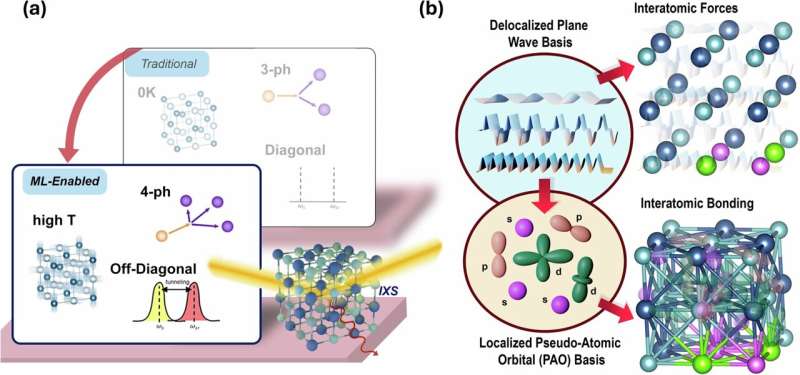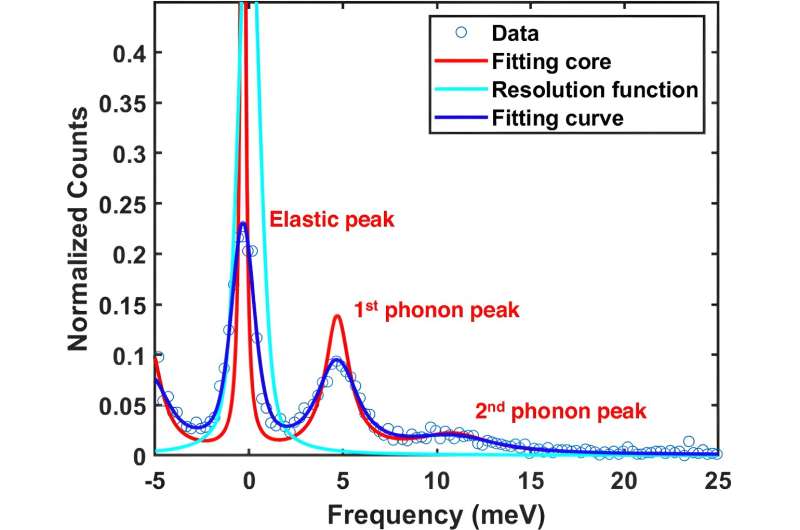This article has been reviewed according to Science X's editorial process and policies. Editors have highlighted the following attributes while ensuring the content's credibility:
fact-checked
peer-reviewed publication
trusted source
proofread
Machine learning explains material's unexpected thermal conductivity

Using a combination of machine learning and powerful X-rays, Cornell researchers have solved a mystery behind the unusual behavior seen in a class of materials with potential for thermoelectric energy conversion and other applications.
Researchers have long shown that the cubic phase of germanium telluride (GeTe) exhibits an unexpected rise in lattice thermal conductivity as its temperature increases. But knowing that a property exists and explaining why it exists are two very different things.
Zhiting Tian, associate professor at the Sibley School of Mechanical and Aerospace Engineering in Cornell Engineering, is the lead author of a paper in Nature Communications that provides a convincing explanation for the unexpected behavior of GeTe. More generally, the research deepens researchers' understanding of thermal transport in a class of materials known as phase-change materials.
What Tian and her team of researchers found is that as a sample of GeTe is heated to the point where its phase changes from a rhombohedral structure to a cubic structure, the bonds between second-nearest neighbors of like atoms (Ge-Ge and Te-Te) strengthen considerably. Ge-Ge bond strength increased by 8.3% and the strength of Te-Te bonds increased by a remarkable 103% as the sample's temperature rose from 693 degres Kelvin to 850 degrees Kelvin.
The group used machine learning-assisted first-principles calculations corroborated by X-ray scattering measurements to computationally reproduce the increasing thermal conductivity trend for the first time. They then borrowed a commonly used chemistry technique to perform the bonding analysis, and confirmed that these increasingly strong second-nearest neighbor bonds play a major role in GeTe's previously unexplained increase in lattice thermal conductivity.

"Computationally, it was quite prohibitive to look at temperature effects and to consider higher-order scattering, for example," Tian said. "But because we were able to leverage machine learning potential, we were able to more efficiently extract the interactions and consider the multiple effects—temperature dependence, four-phonon scattering, and coherence contribution—all at once."
Phase-change materials such as GeTe are valued for their usefulness in a range of optical and electronic applications. Their optical and electrical properties change markedly depending on which of several stable phase states they are in and these phase states can be easily reversed.
Moreover, GeTe has been talked about as a replacement for the semiconductor lead telluride as a thermoelectric material, due to lead's inherent toxicity, according to Tian, who is a faculty fellow at the Cornell Atkinson Center for Sustainability.
The work demonstrates an efficient and thorough pathway toward accurate modeling of materials near phase transitions or at high temperatures that have promise for phase change, thermoelectric and other energy applications.
"We also identified other materials which showed a similar increase in conductivity, including tin-telluride and tin-selenide," Tian said. "And so we hope our work will spark interest in looking deeper into the thermal transport behavior of other phase-change materials."
More information: Samuel Kielar et al, Anomalous lattice thermal conductivity increase with temperature in cubic GeTe correlated with strengthening of second-nearest neighbor bonds, Nature Communications (2024). DOI: 10.1038/s41467-024-51377-8
Journal information: Nature Communications
Provided by Cornell University





















